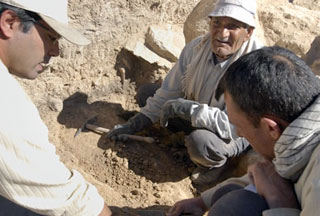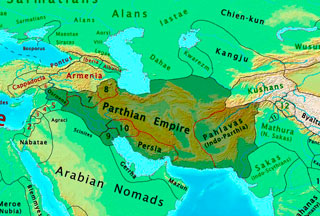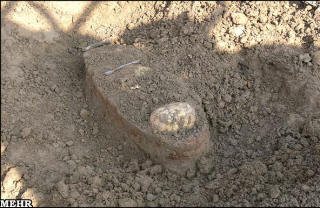

Click here to see index of Parthia in the News articles from all years.
Ancient earthen coffin
found in southern Iran
(1 Jan 2010)
Ancient child’s coffin
unearthed at Parthian site in southwestern Iran (10 Jan 2010)
Tehran, 1 Jan 2010 (PressTV)
 |
An
earthen coffin with a skeleton in it has been discovered in Iran's southwestern
province of Khuzestan, an area rich in oil and history.
The coffin was found in the sand-covered desert hills of Gol Rizvan in the environs of Ramshir city in Khuzestan province. It is believed to have been buried at some point during the almost 500 years of the Parthian Empire (247 BCE - 224 CE). Archaeologists hope that the discovery will give insight into the funerary traditions of the ancient Parthian Empire, which is also known as the Arsacid Empire. At the height of its power, the Parthian Empire ruled most of Greater Iran, Mesopotamia, and Armenia. The indigenous Iranian dynasty well managed to shake off the yoke of Greek dominion in the country and safeguard the rich Persian civilization. The Arsacids were in an almost perpetual state of war to defend the Persian territories against the Roman Empire in the west and nomadic tribes in the east.
During their five-century rein, they fought to capture and hold territory from the contemporary Seleucid Empire, or to prevent vassal states from breaking away. Economically and militarily severely weakened by internal discords and the incessant warring, the Parthian Arsacids were finally vanquished by the Sassanids at around 220 CE. MP/JG/DT (read full article)
|
 |
Tehran, 10 Jan 2010 (Tehran Times
Culture Desk)
 A team of archaeologists has stumbled upon an ancient coffin
bearing a skeleton of a child buried in a Parthian mound in Khuzestan
Province, southwestern Iran.
A team of archaeologists has stumbled upon an ancient coffin
bearing a skeleton of a child buried in a Parthian mound in Khuzestan
Province, southwestern Iran.
The team, which had previously been assigned to demarcate the site, found the coffin in mid December after the recent heavy rainfall removed the earth from the coffin, Khuzestan Cultural Heritage Enthusiasts Society (Taryana) spokesman Mojtaba Gahestuni told the Persian service of the Mehr News Agency on Saturday.
An intact pottery jar and several other artifacts were also buried along with the child in the coffin, he added.
The report did not specify the material used in making the coffin, however it did clarify that the casket along with its contents have been transferred to a governmental organization in the province.
The archaeological team led by Mohsen Hosseini also discovered many intact pieces of pottery and a large number of shards at the mound, leading them to surmise that most likely, there was a large pottery workshop at the site during the Parthian era.
Illegal excavations and farming are currently threatening the ancient sites in the region.
The team has identified traces of illegal excavations on the mound and other ancient sites nearby.
In addition, agricultural activities by the local residents have caused serious damage to some of the ancient sites over the past few decades.
Photo: A part of a skull, which is believed to belong to an ancient child, is seen in the coffin found at a Parthian era site in Iran’s Khuzestan Province in mid December.
-- Mehr/Mojtaba Gahestuni (read full article)
This page last updated 23 Feb 2021